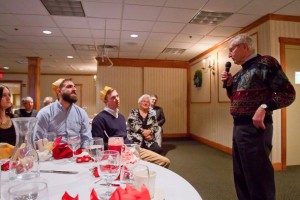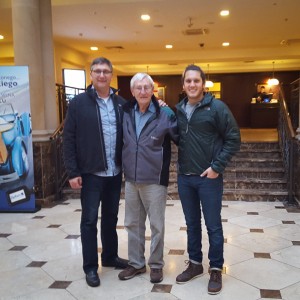Over Christmas dinner in Ohio this year, Jon Styer ‘07 heard his grandfather Ralph Witmer tell about being a “seagoing cowboy,” one of the hundreds of young farmworkers accompanying shiploads of livestock from the United States to aid the rebuilding of post-World War II Europe.
The “cowboys” were part of a joint effort between the Brethren Service Committee of the Church of the Brethren and the United Nations Relief and Rehabilitation Administration. Many of the cowboys were Brethren or Mennonite teenagers or young men from farm communities, but others came from a variety of backgrounds.

By the time the program ended in 1947, more than 7,000 volunteers had made the trip across the ocean. The work still continues today with Heifer International.
Listening to his grandfather’s story was “pretty amazing,” said Styer, who is a graphic designer and brand manager in the marketing and communications office at Eastern Mennonite University. (He couldn’t resist taking a photo of his grandfather telling the story, which you can see to the right.)
“I had heard some of it before,” Styer said, “but this was everything from when he first arrived to what happened on his trip back to Europe.”
In November 2015, Ralph Witmer returned to Poland for the first time. Since returning to Ohio from his trans-Atlantic adventure, Ralph had been a busy entrepreneur: he had farmed the family land, partnered with his cousin (also a seagoing cowboy) to purchase and operate a combine, bought his father’s farm equipment business now known as Witmer’s Inc., and also opened DasDutch Village, an inn, shops and restaurant in Columbiana.

So much had happened in the years between that one might rightly think his activities in Poland could be forgotten. But not so.
On this trip, the 88-year-old was joined by his son, Nelson Witmer ‘87, and Nelson’s son, Alex, class of ‘15. And all three were surprised to find that Witmer and his fellow seagoing cowboys were much appreciated, many years later.
(All nine of Ralph’s children attended Eastern Mennonite University, and seven grandchildren are also alumni.)
Luckily for the rest of us who weren’t at the Witmer family dinner table at Christmas, the story of Ralph’s two trips to Poland was published in early December under the title “Seagoing Cowboys: Ohioan Returns to Poland 69 Years After Historic Voyage” in Farm and Dairy.
Editor Susan Crowell says she had never heard about the cowboys before she received the tip from a Witmers, Inc. employee. “I was so fascinated by the seagoing cowboys, I think I was Googling them while I was still talking to him on the phone,” she said.
Based in Salem, Ohio, Farm and Dairy has a print circulation of 30,000-plus and a readership of more than 75,000. Ralph Witmer, his family and their businesses are well-known in the area, so it’s not surprising that the article Crowell wrote has been shared and read and enjoyed by many.
Since then, Crowell has heard from one other reader who made two trips as a cowboy in 1946 and from historian Peggy Reiff Miller, the granddaughter of a seagoing cowboy, who has been researching the participants and the program since 2002. Miller too had interviewed Ralph Witmer about his adventures.
For those who are interested in learning more about the cowboys, Miller maintains a website and a blog that are both great sources of information where many cowboys and their relatives have shared memories, photos, and reflections about the program that has changed so many lives for generations.
Among other projects with her research, Miller has published a children’s book and created a video documentary. She travels around the world to keep the seagoing cowboy history alive. In 2016, she will tour to promote her new children’s book. She’ll be visiting Harrisonburg and Bridgewater, Virginia; Goshen, Indiana, and other areas of northern Indiana; Elgin, Illinois; Lancaster County, Pennsylvania; North Newton/McPherson, Kansas; central California; Little Rock, Arkansas; and other areas.
“I am open to invitations,” she told EMU News.
Miller says that approximately 1,000 of the 7,000 cowboys were Mennonite. “I’d be happy to know or any cowboys [or cowboy’s relatives] who contact you after your piece is published. There are still many out there with whom I’ve had no contact,” she said.
If you are a seagoing cowboy and EMU alumnus, let us know! Email EMU news editor Lauren Jefferson at lauren.jefferson@emu.edu or call 540-432-4232.

Ralph’s seagoing cowboy experience was a remarkable one. So glad you picked up his story!
My father sailed on the USS Whitney to Poland with a load of about 2,000 horses. I think the time frame was about 1946. I was the last event of his CPS days. He never talked much about it and has now passed so I can’t have that conversation.
My father Paul A. Hershberger was a seagoing cowboy. He didn’t talk about it very much but he was proud to serve by taking cattle to Poland. One of six brothers who grew up on a farm he was a natural pick for this joint effort between the Brethren Service Committee and UN Relief and Rehabilitation. He spoke of the excitement of seeing the free city of Gdansk from the bow of the ship on his trips to Poland. Only two of the six brothers had an interest in farming. My father later learned how to make raw-milk emmental Swiss cheese from first generation Swiss emigrants in Holmes County, Ohio. He eventually had his own company that produced the cheese and won numerous awards. He was 84 living in Lancaster PA when he died in November 2002 from injuries in an auto accident.
His brother William O. Hershberger Jr., who was two years older had a very different story. His response to the pleas to help worn-torn Europe was to enlist in the Army in 1939. He served in Army Intelligence and was part of a covert operation code-named PO Box 1142. The facility was destroyed but it is was set up to interrogate high-level German scientists to find out what they knew The operation is now declassified and I discovered that he also received a letter of commendation for his contribution to the development of the atom bomb. The letter was written by General Leslie Groves who oversaw the construction of the Pentagon and also directed the Manhattan Project. He also was part of the group that briefed President Truman in the Oval Office after FDR died.
My Uncle Bill died at the age of 95 in March 2012. He was proud of his military service and was buried with military honors. His life continues to fascinate me.
Steven K. Hershberger ’75